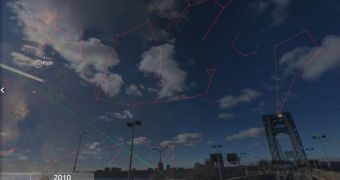Having expanded both Bing Maps and WorldWide Telescope with Silverlight, it was only natural for Microsoft to bridge the two projects, which even at a conceptual level, belong together. Earlier this week the software giant’s mapping, location and search platform grew with the addition of “a universe” of new content. WWT is now a Bing Maps application, revealed Chris Pendleton, the Bing Maps Technical Evangelist for Microsoft. WorldWide Telescope is a Microsoft Research project designed to map the heavens, from our own solar system, to exo planets, galaxies, constellations, nebulae, etc. (hence the "My God... it's full of stars!" reference to Arthur C. Clarke in the tile)
“The WorldWide Telescope application allows you to view most of the features available in the Silverlight client right in Bing Maps. Yes, the WWT provides real time information about how the space is moving over the Earth. This provides context for where celestial entities are in real time if you were to look up at the night sky. Upon launching the WWT Bing Maps App, you may get so excited and just want to see SOMETHING, so just jump right in with stars,” Pendleton stated.
Users will be able to enjoy a deep level of integration between Bing Maps and WorldWide Telescope. In this regard, the Redmond company has already made available StreetSide collections which offer users WWT content. Fact is that all they have to do while exploring street-level imagery is to look up at the sky, and start exploring WWT. Those already familiar with Bing Maps and WorldWide Telescope will have no problems exploring the new materials made available to them.
“You can click the “Start Here” button which enables a telescope mouse pointer which you drag somewhere onto the map. Once you drop it on the map the map will fade to the constellations and stars overhead. You can navigate the universe the same way you do Bing Maps by grabbing an area and dragging the map around (now a universe map). Cool! But, now what. Click the question mark icon near the bottom of the map. This enables a control that you can drag over specific entities on the universe map to identify what they are. You can discover known objects in space…the final frontier. To turn off the information view, just click the question mark icon again,” Pendleton added.
It is extremely simple to get to WWT from Bing Maps. Just use the Silverlight-based version of Bing Maps, and in the left hand side pane click on the Map Apps button at the bottom and choose WorldWide telescope. Information is available on “Constellations, Solar System, All-Sky Surveys, Spitzer Studies, Chandra Studies, Hubble Studies, Astrophotography, Radio Studies, NOAO Studies, Gemini Studies, Messier Catalog, Planets/Moons, Earth (Bing!), Panoramas, and Tours,” according to Pendleton.

 14 DAY TRIAL //
14 DAY TRIAL //